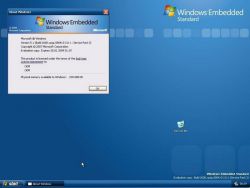Windows Embedded 2009: Difference between revisions
mNo edit summary |
mNo edit summary |
||
| (10 intermediate revisions by 4 users not shown) | |||
| Line 1: | Line 1: | ||
{{Infobox Windows | |||
{{ | |image = R7ofbl.jpg | ||
|image = | |||
|imagecaption = Windows Embedded 2009 | |imagecaption = Windows Embedded 2009 | ||
|codename = | |codename = Quebec | ||
|kernel = NT 5.1 | |kernel = NT 5.1 | ||
|arch = x86 | |arch = x86 | ||
|build = | |build = 5.1.2600 | ||
|release = | |release = 19th December 2008 | ||
|licence = Microsoft EULA | |licence = Microsoft EULA | ||
|support = | |support = 8th January 2019 (Standard)<br>9th April 2019 (PoS) | ||
|previous = [[Windows | |previous = [[Windows XP|Windows XP Embedded]] | ||
|next = [[ | |next = [[Windows Embedded 7]] | ||
}} | }} | ||
'''Windows Embedded 2009''' is a version of [[Windows XP]] SP3 designed for use in embedded units such as car PCs and point-of-sale terminals. | |||
Windows Embedded 2009 is | |||
Like former versions of Windows XP Embedded, Windows Embedded Standard 2009 is based on Windows XP Professional. The system uses granular building blocks of functionality, which are known as components, to create custom operating system images for embedded devices. Using this approach, OEMs can customizethe OS according to the exact requirements of their current project. This enables flexibility and control over the complete OS infrastructure, as well as applications that run on target devices. In addition, Windows Embedded Standard 2009 includes a comprehensive set of Embedded Enabling Features (EEFs) to provide embedded-specific functionalities, such as disk | Like former versions of Windows XP Embedded, Windows Embedded Standard 2009 is based on Windows XP Professional. The system uses granular building blocks of functionality, which are known as components, to create custom operating system images for embedded devices. Using this approach, OEMs can customizethe OS according to the exact requirements of their current project. This enables flexibility and control over the complete OS infrastructure, as well as applications that run on target devices. In addition, Windows Embedded Standard 2009 includes a comprehensive set of Embedded Enabling Features (EEFs) to provide embedded-specific functionalities, such as disk | ||
protection, fast start up, and device management. | protection, fast start up, and device management. | ||
[[Category:Microsoft Windows]] | |||
Latest revision as of 19:52, 5 May 2020
 |
|
| Windows Embedded 2009 | |
| Codename Preliminary name |
Quebec |
|---|---|
| Kernel version | NT 5.1 |
| CPU architecture | x86 |
| Release date | 19th December 2008 |
| Support end | 8th January 2019 (Standard) 9th April 2019 (PoS) |
| Preceded by | Windows XP Embedded |
| Succeeded by | Windows Embedded 7 |
Windows Embedded 2009 is a version of Windows XP SP3 designed for use in embedded units such as car PCs and point-of-sale terminals.
Like former versions of Windows XP Embedded, Windows Embedded Standard 2009 is based on Windows XP Professional. The system uses granular building blocks of functionality, which are known as components, to create custom operating system images for embedded devices. Using this approach, OEMs can customizethe OS according to the exact requirements of their current project. This enables flexibility and control over the complete OS infrastructure, as well as applications that run on target devices. In addition, Windows Embedded Standard 2009 includes a comprehensive set of Embedded Enabling Features (EEFs) to provide embedded-specific functionalities, such as disk protection, fast start up, and device management.